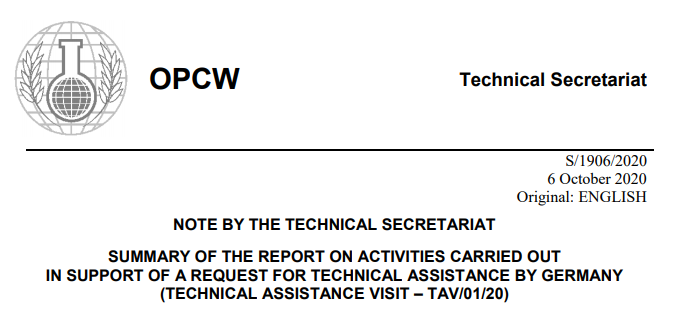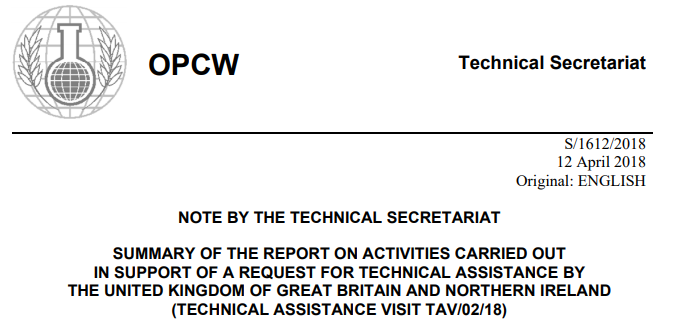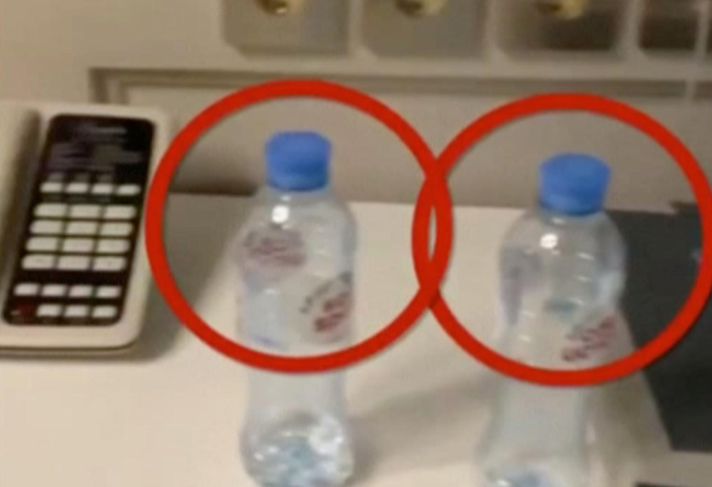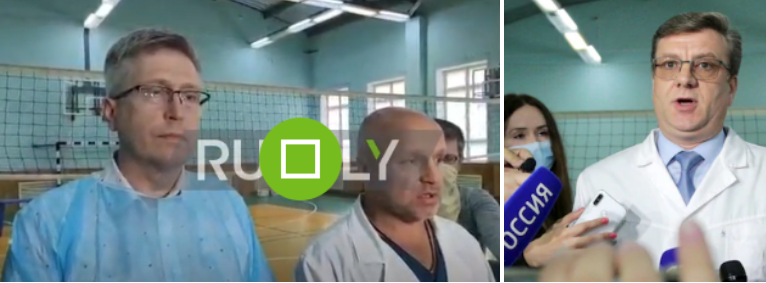

by John Helmer, Moscow
@bears_with
A report issued by the Organisation for the Prohibition of Chemical Weapons (OPCW), dated on October 6, has failed to identify the poison weapon which Alexei Navalny and his supporters claim was used to attack him in a Tomsk hotel on August 20.
Instead, the OPCW claims to have found “biomarkers” of Navalny’s metabolic disorder which may have been caused by an unidentified chemical poison. According to a leading British organophosphate chemist, these “biomarkers” may not have been caused by a crime.
“Biomarkers is the wrong term. Biomarkers means metabolites or other compounds which are not the parent nerve agent compound. The vagueness could mean anything,” the expert, who has requested anonymity, concludes. “As always, we need the compound name, but the labs are indicating that somehow they knew they were not identifying a metabolite. Somehow the Germans and the two other labs knew that the compound they identified were not metabolites, they were the parent novel compound. How could they know this?”
The OPCW report, which has been exceptionally delayed before public release, also acknowledges that it did not investigate the Tomsk hotel water bottles which Navalny and his associates have claimed to be the murder weapon. The OPCW analysis also ignored Navalny’s clothing,which he and his associates have insisted to be additional evidence of the alleged assassination attempt.
“If this were expert evidence at the Old Bailey,” a London criminal law source comments, “the defence would rise to say it is evidence of the victim’s illness. It is not identification of the weapon. It’s not evidence of a crime. So there is no case to answer here. The prosecution’s case has failed and should be dismissed.”
According to the OPCW press release of October 6, the organisation in The Hague “had transmitted yesterday [October 5] to the Federal Republic of Germany the report of the OPCW’s mission to provide requested technical assistance in regard to the poisoning of Mr Alexei Navalny, on 20 August 2020.”
The press release says “poisoning”. The official “Note by the Technical Secretariat” does not say this.

Source: https://www.opcw.org/
Reporting by Florian Roetzer in Telepolis concludes that “the analysed compound is apparently not officially prohibited under the Chemical Weapons Convention. As in the case of Skripal, when it is alleged to have been Novichok A234 , the OPCW does not use this term, nor does it speak directly of a chemical weapon, but rather indeterminately of a toxic chemical. There is also nothing in the published report about where the poison came from.”
According to the OPCW report, “the biomarkers of the cholinesterase inhibitor found in Mr Navalny’s blood and urine samples have similar structural characteristics to the toxic chemicals belonging to schedules 1.A.14 and 1.A.15, which were added to the Annex on Chemicals to the Convention at the Twenty-Fourth Session of the Conference of the States Parties in November 2019. This cholinesterase inhibitor is not listed in the Annex on Chemicals to the Convention.” The OPCW report concluded “that Mr Navalny was exposed to a toxic chemical acting as a cholinesterase inhibitor.”
The one-page document adds that the “biomarkers”, but not the “toxic chemical”, have been “identified …in the classified report of the Secretariat.”
The OPCW now reveals that the organisation had acted much earlier than previously reported. It was on September 5 that the OPCW technical team arrived in Berlin to be briefed by German government “authorities”; the OPCW document also reveals these were German government officials, not medical specialists. On the next day, September 6, the OPCW now says Navalny’s urine and blood were sampled, and taken back to the OPCW laboratory in The Hague.
A week later, on September 13, the OPCW was officially refusing to answer questions about the mission which had been sent and returned. The two OPCW officials who were stonewalling on what they had known for a week were the organisation’s spokesman, Deepti Choubey, an American; and her superior, Kai Chen, a Chinese who is the OPCW’s official in charge of “liais[on] with governments, international organisations, the media, and non-governmental organisations”. On the telephone at his office, Chen lied, claiming he knew nothing about OPCW’s involvement in Germany at the time.
The OPCW was still concealing what its analysts had done in Berlin, and what they had already analysed from the samples in The Netherlands on September 14, when the German Government spokesman, Steffen Seibert, announced the OPCW’s “involvement”. Seibert was also covering up.

Left to right: Deepti Choubey and Kai Chen of the OPCW; Steffen Seibert, German Government spokesman.
According to Seibert’s announcement, “the Federal Government has therefore included the OPCW in the analysis of evidence in the Navalny case. This involvement of the OPCW is based on Art. VIII 38 (e) of the CWC [Chemical Weapons Convention], which gives all contracting states the opportunity to receive technical support from the OPCW. On this basis, the OPCW took samples from Mr. Navalny and took the necessary steps to have them examined by the OPCW reference laboratories.”
In fact, the OPCW now reveals, it had held on to the Navalny samples for a working week, until “a request from Germany [arrived] on 11 September 2020, [when] the OPCW Laboratory sent the samples to two laboratories designated by the Director-General for the analysis of biomedical samples.” The OPCW has not named these laboratories. There is also no explanation for the week-long delay in German permission for the OPCW to send the samples to the two “reference laboratories”. If these labs were in Switzerland and other countries, the delay may have reflected reluctance by the governments of those countries to get involved.
These labs appear not to be the French and Swedish military warfare units which had already, by September 14, confirmed what the OPCW now acknowledges its analysts had not discovered. According to the Associated Press report, the Swedish unit involved was the Swedish Defence Research Agency.
The delay at OPCW headquarters over what to do with Navalny’s blood and urine, and then what to report publicly, is much longer than the OPCW, under British pressure, reported when its technical team took samples from Sergei Skripal, Yulia Skripal and the local policeman Nicholas Bailey in Salisbury Hospital two years ago.

Source: https://www.opcw.org/
The Skripal technical assistance visit (TAV) was reported at the hospital on March 21-23, 2018; the OPCW then followed by issuing its report on April 12. That’s an interval of 20 days. The time from sampling Navalny in Berlin to reporting yesterday is 30 days.
In England, the OPCW followed the Skripal case with two TAVs to investigate the alleged use of Novichok by Dawn Sturgess on June 30, 2018. The first TAV took place on July 15-18, 2018, the week following Sturgess’s death in hospital. The team then returned for a second inspection on August 13. A public version of the technical report was issued on September 4, 22 days later.
For the full story of the fabrication of evidence by the OPCW and the British authorities in the Skripal case, read the book.
The reason for the OPCW’s delay is now exposed by the failure of this week’s report to confirm what Seibert and other German government officials have been claiming to be their evidence of a Novichok assassination attempt against Navalny. Seibert hinted at this himself in his September 14 statement. “The federal government,” he said, “has also asked other European partners with France and Sweden for an independent review of the German evidence based on new samples from Mr. Navalny. The results of this review by special laboratories in France and Sweden are now available and confirm the German evidence. Regardless of the ongoing investigations by the OPCW, three laboratories have now independently provided evidence of a nerve agent from the Novichok group as the cause of Mr. Navalny’s poisoning. We renew the call for Russia to explain what has happened” (emphasis added).
Seibert’s qualifier reveals that German officials already knew there was a problem with the Novichok story in the samples the OPCW had been analysing in The Hague, and in its “reference laboratories”. So Seibert qualified his allegation — “regardless of the ongoing investigations by the OPCW”. In other words, the only source of evidence for the Novichok crime was hearsay from Seibert about secret reports from three military agencies – German, French, Swedish.
The OPCW report now reveals that Seibert knew the German Government was deliberately withholding from the OPCW team the evidence of the crime which Navalny, his wife and his associates have publicly announced to be the smoking gun.

Alexei Navalny, with his wife Yulia Navalnaya, present a 2-hour film of their duplex apartment in Berlin, their CD and DVD collection, Navalny’s full recovery, and repetition of their allegations of a Russian crime. “The infection occurred at the hotel. Then three or four hours passed — a long period…I either touched, well, listen, it could have been [like]: I was taking my shirt off the hanger, I touched the hanger — and hello! It could be on clothes, it could be anywhere, really.” The YouTube clip is dated October 5.
According to the new OPCW document, “the team was informed that the mission was restricted to the collection of biomedical samples from Mr Navalny.” There is no explanation of why this restriction of evidence testing was ordered by the Germans or agreed to by the OPCW.
The OPCW adds discreetly: “No other information was shared by the German authorities.” The term wasn’t “shared”; it was “allowed”. This exposes manipulation of the OPCW testing process by the German Government; it has tampered with the evidence.

In the Reuters report of the Navalny group’s allegations of the evidence of Novichok poisoning, two empty water bottles were displayed before they were taken to Berlin and then tested in Munich. Navalny has subsequently told Der Spiegel that the bottles were “harmless. It was a minimal amount of poison. Anyone could have touched it without suffering any harm.” Subsequent reporting by the Navalny group has claimed that three bottles turned up in Germany, and that they contained water, although that had not been visible when they were filmed in Tomsk.
To independent biomedical experts, the OPCW document reveals that blood and urine samples were the only evidence analysed by the OPCW laboratories. The bottles, carefully removed from Navalny’s Tomsk hotel room and taken to Germany on the medical evacuation flight carrying Navalny, were then sent to the German Army laboratory in Munich, where they became the evidence for the September 2 announcement by Seibert: “at the instigation of the Charité medical university Berlin a special laboratory of the armed forces carried out a toxicological investigation [toxikologische Untersuchung] on the basis of Alexei Navalny’s tests [proben]. On this occasion, the definite proof [zweifelsfreie Nachweis] of a chemical nerve agent of the Novichok group was produced.”
The OPCW report of October 6 makes a liar of Seibert on September 2. The OPCW analysis reports no “definite proof of a chemical nerve agent of the Novichok group”.
According to the British organophosphate expert, “in a routine toxicology protocol the Acetylcholine Esterase [ACE] would be measured first as a general, non-specific assay. It would not normally be that the lab would look for an ACE inhibitor unless there was evidence that ACE was low. No doubt the two [OPCW] labs were told what to look for.” But the reported findings “are the compounds added to the Schedule [Schedule 1 of the Annex on Chemicals as amended on June 7, 2020] after Skripal. The vagueness could mean anything — a compound with a similar structure to A234, but not A234? As always, we need the compound name, but the [OPCW] labs are indicating that somehow they knew they were not identifying a metabolite. Somehow the Germans and the two other labs knew that the compound they identified was not metabolites, they were the parent novel compound. How could they know this?”
The wording of the OPCW report is a cover-up of what has not been found.

Source: https://www.opcw.org/
The British chemist again: “the key phrase, ‘the biomarkers of the cholinesterase inhibitors’, is a mistake. ‘Biomarkers’ is the wrong word. Biomarkers means metabolites or other compounds which are not the parent nerve agent compound. If you drink vodka, then a month later we can find Ethyl Glucuronide in your hair — EtG as we call it. EtG is a biomarker for ethanol ingestion. But it is not ethanol; it has a completely different structure. The human liver forms the glucuronide to help the body metabolise the ethanol. So what we have here is that the OPCW is using that word to imply there was no parent nerve agent found.”
Medical experts note that the testing of Navalny’s blood and urine in Omsk Hospital, after he was admitted on August 20 but before he was flown to Berlin, reported that “cholinesterase inhibitors were not detected in blood and urine.” The experts say the wording of the Russian test reports and the wording of the OPCW report are ambiguous enough for both sets of findings to be true.

Omsk Hospital doctors, Anatoly Kalinichenko (centre) and Alexander Murakhovsky (right), briefing the press on the pathology testing of Navalny’s blood and urine.
Medical experts believe the OPCW presents no conclusive evidence that the biomarkers which have been identified could only have been produced by a chemical nerve weapon. They do not rule out another source. “This may be look like a gun,” one source comments, “but whatever it is, it isn’t smoking.”











Leave a Reply